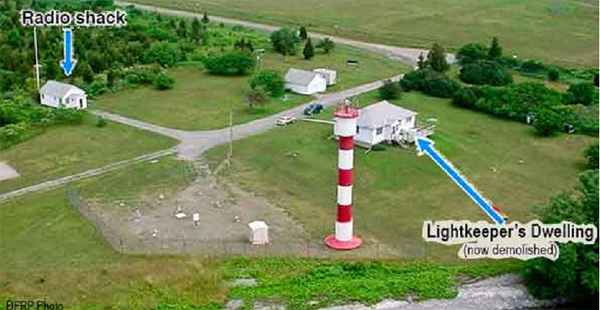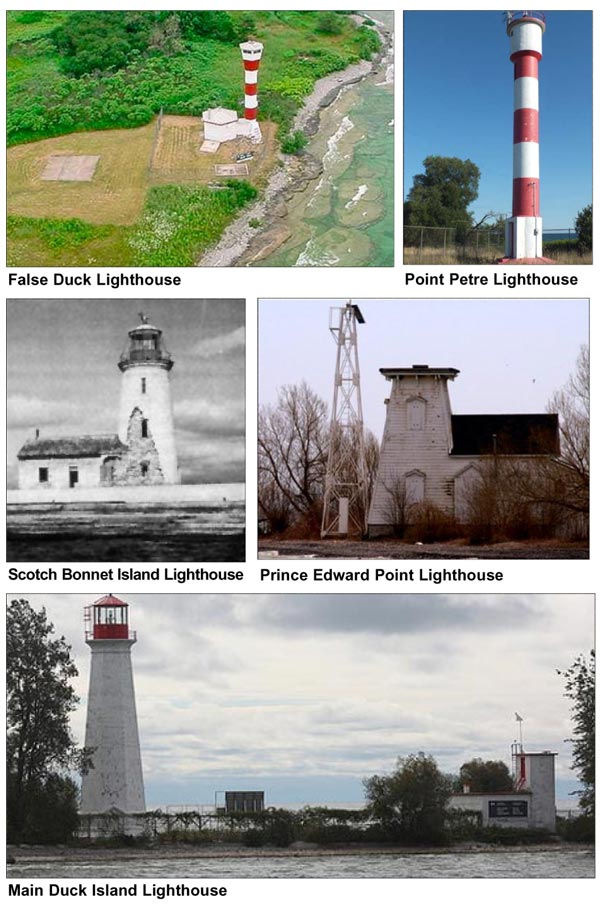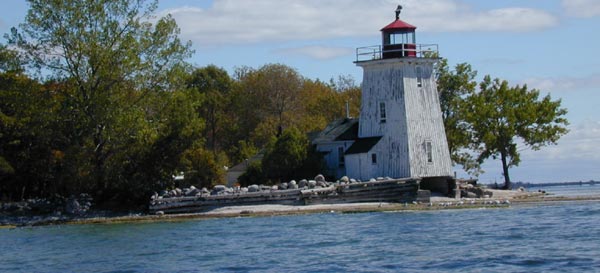Save our Lighthouses seeks help to save Point Petre site from further demolition
Administrator | Aug 16, 2022 | Comments 1
 In an attempt to highlight the grave concern over the potential imminent demolition of Point Petre lighthouse located on the southern-most tip of Prince Edward County, historian Marc Seguin made a plea to the municipality in a bid to help save the important maritime structure, as well as associated buildings on the site.
In an attempt to highlight the grave concern over the potential imminent demolition of Point Petre lighthouse located on the southern-most tip of Prince Edward County, historian Marc Seguin made a plea to the municipality in a bid to help save the important maritime structure, as well as associated buildings on the site.
Seguin’s main message to the Prince Edward Heritage Advisory Committee (PEHAC) last week was that any and all demolitions at the Point Petre site be halted. His request for the municipality’s support comes before council tonight.
Seguin has written extensively about lighthouses and shipping around the area and his concern is for all Prince Edward County heritage lighthouses, which he says are all at risk.
Seguin is executive director of Save Our Lighthouses and is a director with the Architectural Conservancy of Ontario.
“In all, between 1828 and 1967, 14 significant lighthouses were built in Prince Edward County, all of them helped to guide ships safely along the Bay of Quinte, and through the treacherous waters known as the graveyard of Lake Ontario.”
Of the 14 lighthouses, eight have been demolished, with only two replacement lighthouses having been built.
“We now have only six historic lighthouses still standing and they are all under threat.”
It was the recent and sudden demolition of the lightkeeper’s dwelling (circa 1960) in mid-July by the federal government at the Point Petre lighthouse site that pressed local heritage conservation groups into action.
Seguin’s request to the municipality, through mayor Steve Ferguson and council, via the PEHAC, is to send a letter to the Minister of the Environment to halt further demolitions of the heritage buildings at the Point Petre lighthouse complex.
Further, it was suggested the letter also encourage the Ministry of the Environment and Climate Change Canada, and its department Parks Canada, to prioritize the conservation of the Point Petre lighthouse and radio shack under the Heritage Lighthouse Protection Act (HLPA).
PEHAC member Liz Driver said while the lighthouse itself is the primary building, it is the auxiliary buildings that add additional cultural meaning to the site.
“The lightkeeper’s cottage has been lost, but the radio shack helps to interpret and comment upon all the mechanisms that went towards keeping mariners safe,” said Driver.
She suggested an adaptive re-use of the Point Petre site similar to the way the Hudgin Log House located on the South Shore is being preserved, conserved and adaptively reused.
“The radio shack, if preserved, also provides opportunities for human activities down at Point Petre; it would facilitate use of the site by residents, tourists, and would allow some kind of activity and adaptive reuse, that’s why it’s really important to halt further demolitions now.“
The third and final ask by Seguin is for the mayor, with the support of the PEHAC, to invite a representative of the Environment and Climate Change Canada to make a presentation at a future council meeting to discuss the plans for Point Petre lighthouse site.
“It’s absolutely critical to have the conversation” added Driver. “By extending a friendly invitation for someone from the ministry to come and speak to council, it would begin the conversation and it would be an opportunity to express why this site means so much to us.“
Mayor Ferguson reminded the site is currently not open to the public as it has a fence around it, and asked if the end game was to allow public access to the radio shack.
“The process of designation requires a third party to take over some aspect of the site and some form of adaptive reuse and the purpose would be public access,” confirmed Driver. “To succeed here, there are a lot of steps ahead: the first one is to stop the demolition and have the community find a solution for adaptive reuse.”
In his deputation to the PEHAC, Seguin spoke to the County’s heritage lighthouses generally and what can be done to help conserve them.
“These lighthouses are the last few vestiges of our marine heritage and they are now under threat of disappearing forever,” said Seguin. “The situation at Point Petre is especially alarming.”
The original Point Petre lighthouse, built in 1832, was demolished in 1970, with the current lighthouse built in 1967, where the Point Petre heritage complex remains an important site and includes six important areas within the site.
It is the site of the original lighthouse, the sites of the first two lightkeeper’s cottages, the current lighthouse (no current known plans for demolition), and the lightkeeper’s cottage (recently demolished), and the radio shack which held equipment for radio beacon navigation (scheduled to be demolished).
The radio shack (circa 1955) located on the site held equipment for radio-beacon navigation system, is currently scheduled to be demolished.
“The lighthouse itself is not in great shape as no maintenance has been done on it for many years, and ultimately it will be demolished if there is no maintenance done on it,” noted Seguin.
The Point Petre lighthouse is still in operation and is still an active aid to navigation.
“The unique reinforced concrete tower of the replacement 1967 lighthouse has significant heritage value, architectural value, cultural value and contextual value,” expressed Seguin.
He said all related buildings are also eligible for HLPA designation.
It was explained that the complicating issue at the Point Petre site is the split control of the site with the lighthouse being controlled by the DFO (Department of Fisheries and Oceans), but the surrounding property (including the now demolished lightkeeper’s cottage and the radio shack) is controlled by Environment Canada.
The lighthouse heritage program is administered by Parks Canada.
“Even though the lighthouse and related buildings are still being considered for HLPA designation, Environment Canada went ahead and demolished the lightkeeper’s dwelling anyway, and have plans to demolish the radio shack as well,” added Seguin.
“Collectively, these government departments have ignored or circumvented heritage legislation and internal government policies concerning heritage structures.”
Seguin reminded that the municipality has no power to effectively designate or stop demolition of any structure on Government of Canada property.
His request also included other federally-owned lighthouses be conserved as stipulated under the Heritage Lighthouse Protection Act.
 OTHER COUNTY LIGHTHOUSES
OTHER COUNTY LIGHTHOUSES
Of the six remaining iconic lighthouses in the County still standing, each in varying states of repair, all are under threat, according to Seguin. They include the lighthouses at Salmon Point (built 1871), Scotch Bonnet Island (built 1856), Main Duck Island (built 1914), False Ducks Island (1965) and Prince Edward Point (Point Traverse) (built 1881).
“Only these six iconic towers remain as reminders of our once-vital marine commerce that made significant contributions to the development of Prince Edward County, of Ontario, and of Canada,” noted Seguin.
The current status of the six remaining County lighthouses was briefly outlined by Seguin.
He noted Scotch Bonnet Island lighthouse, now a ruin, and Prince Edward Point (Point Traverse) have been “protected” since 2015 under the Heritage Lighthouse Protection Act (HLPA).
“The owner (Government of Canada) is required to “conserve” the lighthouses; Scotch Bonnet Island is a ruin and should be stabilized as such, but it is not being conserved,” he said.
He noted Prince Edward Point has been stabilized with a new outer skin to protect the fabric of the building.
“It needs to be re-purposed to allow community access and on-going upkeep, otherwise it will not survive,” he added.
Seguin said he would be interested to hear about any ideas for the adaptive re-use of Point Traverse lighthouse.
Main Duck Island, False Ducks Island and Point Petre lighthouses are currently owned by the Government of Canada and controlled by Fisheries and Oceans, and are surplus lighthouses and eligible for protection under HLPA.
He noted the Hastings Prince Edward Land Trust has submitted proposals to conserve each of the three lighthouses.
A HLPA designation would also include all the buildings related to the lighthouses, but in order for that to occur, they must be transferred to the province, municipality or a community group where they will be required to be conserved by the new owner.
Seguin noted too that the current aid to navigation must remain in place, to be maintained by the DFO.

Salmon Point Lighthouse
SALMON POINT LIGHTHOUSE
Salmon Point lighthouse is the only local lighthouse privately owned, and as such it has no heritage protection. It is currently in a dilapidated state, according to Seguin.
“The owners have refused all offers of help from the community to maintain the lighthouse,” he noted.
He said about five years ago, PEHAC advised council to designate the lighthouse under part four of the Ontario Heritage Act, but the owners didn’t want this to happen.
“They threatened to take the County to court and entangle us in protracted costly legal actions,” he explained. “In the face of this, County council backed down and the lighthouse is rotting away.”
Seguin noted that not only is Salmon Point lighthouse of significant heritage value to the County, it is also a memorial to the six mariners who lost their lives at Salmon Point in1870.
Salmon Point is also the site of Canada’s first live-saving station on the Great Lakes, established in 1871.
“This iconic structure deserves to be protected and can be designated by the County.”
Seguin’s request to the municipality also asks that the process of municipal heritage designation for Salmon Point lighthouse be restarted.
He noted that many other lighthouses across Ontario have been designated under part four of the Ontario Heritage Act.
The remaining lighthouses in the County are owned by the government of Canada and fall under the 2008 Heritage Lighthouse Protection Act (HLPA).
Seguin further noted than any of the more 400 federally owned lighthouses across Canada could be designated under the act. Most are controlled by Fisheries and Oceans Canada; 300 were declared surplus by DFO.
“In order to be designated a surplus lighthouse it would first have to be transferred to a province, municipality or community organization who would promise to conserve the lighthouse.”
Since 2015, just over 100 lighthouses have designated under the act, with still 100 or more eligible to be designated.
Since 2015, two of the federally-owned lighthouses in the County are protected under the HLPA and were not declared surplus, namely Scotch Bonnet Island lighthouse and Prince Edward Point (Point Traverse) lighthouse.
Filed Under: Local News
About the Author:

































I spend time at Pt. Petre in the spring during the bird spring migration. The lighthouse area is extensive and completely fenced off. I suspect that the buildings have fallen into disrepair but it would be a shame to not preserve the actual lighthouse. If this could be done, and the area opened up for general use, I would be in favour. In its current state, it isn’t much good to anyone. Take down the fence!